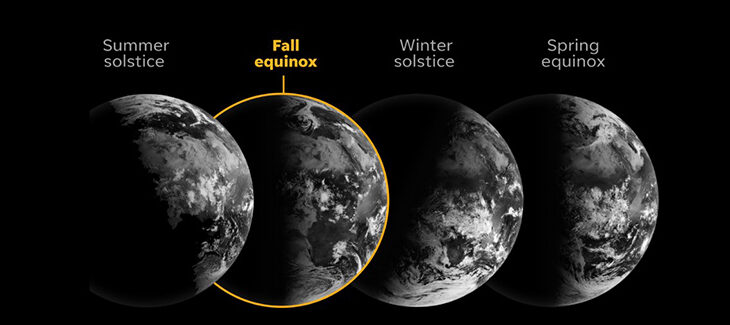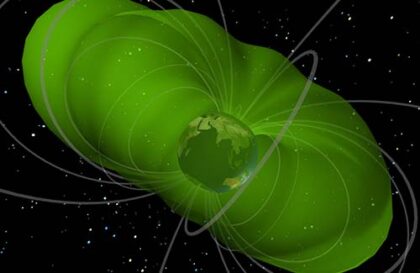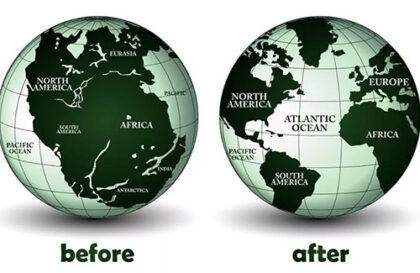Officially, the equinox occurred on September 23, 2023, at 06:50 GMT.
But this year it will happen three days later. And this is not a prank.
During the equinox, the Sun crosses the celestial equator, moving from the northern to the southern hemisphere. An exceptional feature of this phenomenon is that day and night on this day are approximately equal in duration anywhere on our planet. And the key word here is approximately.
On the day of the equinox, day is not equal to night
When the edge of the Sun touches the horizon, it disappears behind it, but it seems to us that it is still visible due to the bending of light rays passing through our atmosphere. This process of refraction or refraction causes the Sun to “linger” on the horizon a little longer than it is there.
Considering atmospheric refraction, the day at the spring or autumn equinox is slightly longer than the night, especially at high latitudes.
Now, if the Earth did not have an atmosphere or the Sun was a point source of light, then the Sun on this day would travel 12 hours above the horizon and 12 hours below the horizon. There would be no such thing as twilight.
Refraction makes objects appear higher in the sky. Credit: Time and Date
The length of daylight during the equinox is slightly more than 12 hours due to the way sunrise and sunset are determined. This is due to refraction in the atmosphere, and the moment of sunrise or sunset is considered to be the appearance or disappearance of the edge of the Sun (upper limb) and not its center. Therefore, despite the concept of “equality of day and night” in practice, the day is slightly longer.
For example, according to Time and Date the day of September 23 lasted 12:09:39 hours in Greenwich. In Miami, we admired the Sun for three minutes less, and in Anchorage for a minute more.
At the North Pole, during the equinox, the Sun moves across the horizon 360 degrees, creating the impression of a continuous day. However, due to refraction in the atmosphere, the Sun remains visible even after the point at which it should theoretically disappear. The same refraction effect makes the solar disk oval as it approaches the horizon since the lower edge of the disk rises faster than the upper.
Thus, September 23 cannot be the equinox. Day will be equal to night, in fact, on September 26 for those located at 35-40 degrees north latitude. For residents of 20 degrees north latitude. The equinox will come one more time later. But the residents of 5 degrees north latitude. We will meet the equinox only on October 17th.
In an ideal world, where sunrise and sunset were determined by the moment the center of the Sun passed beyond the horizon, day and night would be 12 hours each. However, in practice, the moment when the upper part of the Sun touches the horizon is considered. This process takes a few minutes, making the day slightly longer than the night during the equinoxes.
At the equator, there are no equal days and nights.
There is more light time than dark
In fact, in the Arctic region, depending on the latitude and time of year, there is a period when the Sun never wholly disappears below the horizon (midnight sun) and when the Sun never rises above the horizon (polar night). But between these periods, there are long phases of twilight.
Twilight is when the Sun is below the horizon, but the sky is still lit. Twilight is divided into civil, nautical, and astronomical, depending on how deep the Sun is below the horizon.
Astronomical twilight
Astronomical twilight ends when the Sun drops 18 degrees or more below the horizon. A clenched fist at arm’s length covers about 10 degrees.
Credit: Time and Date
Even during the polar night, when the Sun does not rise above the horizon in the Arctic and Antarctic regions, the sky does not remain completely dark throughout the day. The reason for this is atmospheric refraction and light scattering.
Polar twilight is a phenomenon when the Sun is below the horizon, but its light still reaches the sky due to refraction in the Earth’s atmosphere. This creates low light, and although the Sun is not visible, the sky does not become completely dark.
This polar twilight can last several hours or even days, depending on latitude and time of year. In some places high in the Arctic or Antarctica, polar twilight lasts several weeks.
Astronomical twilight at the North Pole ends on November 13 and returns on January 29. Thus, continuous darkness lasts about 11 weeks rather than half a year.
Civil twilight
Civil or bright twilight occurs when the Sun descends below the horizon at an angle of less than 6 degrees. This is when many outdoor activities can be continued without additional lighting. Several publications often recommend turning on car headlights at this time, which usually coincides with the end of civil twilight.
So, even when the Sun disappears at the North Pole for six months starting on September 25, it would be wrong to say there is complete darkness. Civil twilight will continue to glow until October 8th.
Nautical twilight
When the Sun goes 12 degrees below the horizon, this signals the end of Nautical twilight, during which it is already difficult to determine the sea horizon. In fact, for many, this is the moment the night begins. At the North Pole, the whole night occurs only after October 25th.
Why is sometimes day equal to night?
The Earth orbits the Sun at an angle of approximately 23.5 degrees, resulting in differences in day length at different latitudes at different times of the year. Although the Sun rises in the east and sets in the west everywhere, its trajectory changes and appears to move towards the north or south. In July, days in the northern hemisphere are longer, and in the southern hemisphere shorter, in December – and vice versa.
However, twice a year – in March and September – the position of the Earth relative to the Sun is such that its axis is not inclined towards it but is strictly perpendicular to the sun’s rays.
During these periods, the Sun is directly above the equator, making the length of day and night the same in both hemispheres. The boundary between light and shadow, known as the terminator or “twilight line,” divides our planet into two equal parts, passing through the North and South Poles.
On the day of the equinox, the tilt of the earth’s axis is perpendicular to the sun’s rays, as shown in the figure. Credit: Time and Date
How often do equinoxes occur?
The equinoxes occur around March 20 and September 23, but the dates vary because the year is not precisely 365 days. These “extra” 6 hours of the day shift the equinox date every year. The Earth also changes its position relative to the Sun, affecting these dates. Astronomically, the equinoxes mark the beginning of spring or fall, but meteorologists begin the seasons on March 1 and September 1.
The Earth is not the only one that experiences equinoxes. Every planet in the solar system has them, where the planet’s orbit and tilt relative to the Sun results in both hemispheres receiving roughly the same amount of light.
Who was the first to track the equinoxes?
People have observed the Sun for millennia, incorporating the equinoxes into their traditions. These events often indicated changing seasons and agricultural cycles. In Japan, equinoxes are public holidays, days of remembrance of the departed. The Hindu complex of Angkor Wat in Cambodia has an astronomical alignment with the equinoxes. The Mayan temple in Chichen Itza, Mexico, displays a light illusion that resembles a descending snake.
Banner image: Satellite views of Earth offer a simple way to grasp the reason for the seasons. Credit: NASA/USA TODAY
Image credit:
https://eu.usatoday.com
https://www.timeanddate.com
https://www.timeanddate.com
https://www.timeanddate.com






